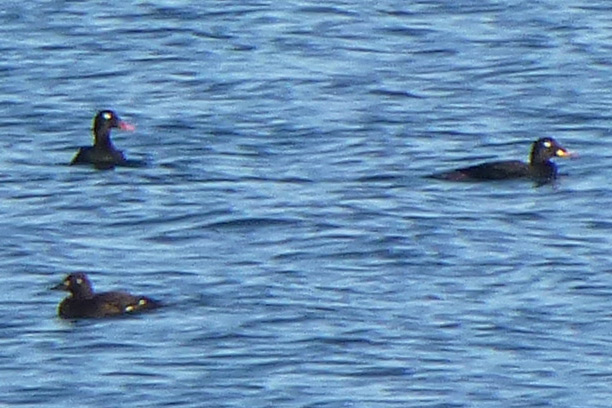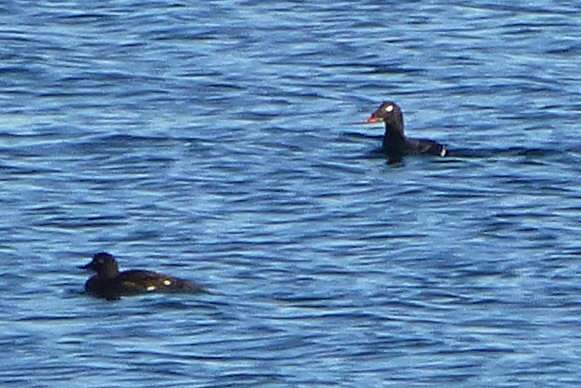Rather surprising news emerged late on Saturday 12th, when Owen Selly appealed for confirmation on what he suspected to be a drake White-winged Scoter, photographed early afternoon on Boxing Day off Musselburgh (Lothian). Owen summarizes the discovery below:
"On Boxing Day we were at Musselburgh, one of our favorite birding sites, hoping to see a few more species before the end of the year. I headed straight for the Esk Mouth where a long staying drake Surf Scoter had been reported. My wife Sarah-Louise wanted to get some reference photos to better learn scoter identification, so she stopped at the seawall near the lagoons as there was large group of Velvet Scoters reasonably close to shore. Two weeks passed before we got a chance to go through the images and that's when I noticed it. It wasn't a 'eureka' moment — more of creeping realisation. I have little experience of White-winged Scoter, having only seen them once in poor conditions in Washington State; my memory was twigged more by images I'd seen of the Aberdeenshire bird. It seemed so unlikely that I initially assumed I had overlooked some obscure piece of birding knowledge such as an aberrant Velvet Scoter, but the ever-helpful crowd on BirdForum were happy to confirm the ID. It's led to an interesting discussion over who gets credit for the find — something that must be happening more and more with digital photography becoming so commonplace — but as far as we're concerned, we share it. I really hope the bird is refound: apart from anything else I would like to be able to say I've actually seen it!"
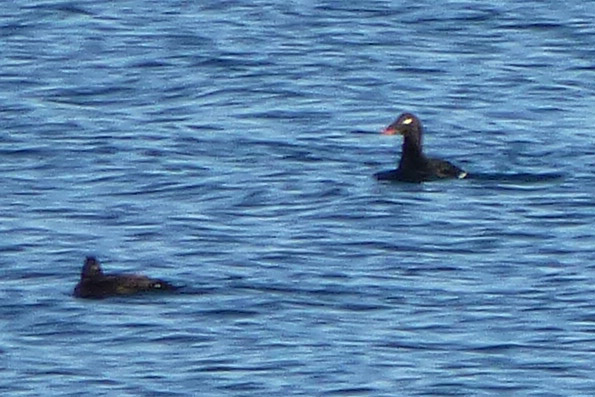
Images 1—3: the Musselburgh 'White-winged Scoter', photographed on Boxing Day 2013 and cropped to 100%. In the top image, it is the top left-hand bird, while in the bottom two it is on the right (Photos: Sarah-Louise Selly)
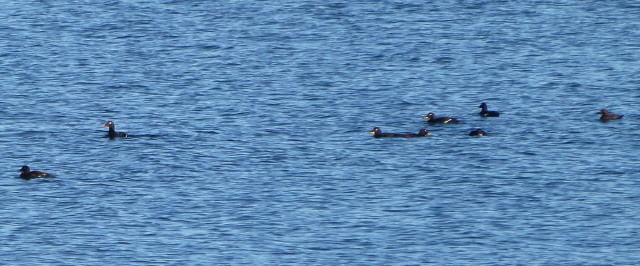
Image 4: A less heavily cropped reproduction of image 2 above, to give an the distance of the bird, pictured here with Velvet Scoters — the White-winged is second from left (Photo: Sarah-Louise Selly)
Analysis and identification
Though both Stejneger's Scoter (Melanitta deglandi stejnegeri) and American White-winged Scoter (M. d. deglandi) are currently 'lumped' as one (i.e. 'White-winged Scoter' M. deglandi), the two are strong candidates to be split into separate species in the near future. Adult drakes of stejnegeri and deglandi can be easily differentiated with good views due to differing head shape and profile as well as bill structure and colouration, while the latter shows dark brown flanks in contrast to the former's black.
Breeding in Siberia, Stejneger's Scoter has occurred once previously in Ireland (in Rossbeigh, Co. Kerry; read an account of its discovery here) but not before in Britain. Its American counterpart famously turned up in Aberdeenshire just a few months after the Kerry bird and, although not a glorious adult drake, posed an altogether more challenging identification and was a find of the highest order.
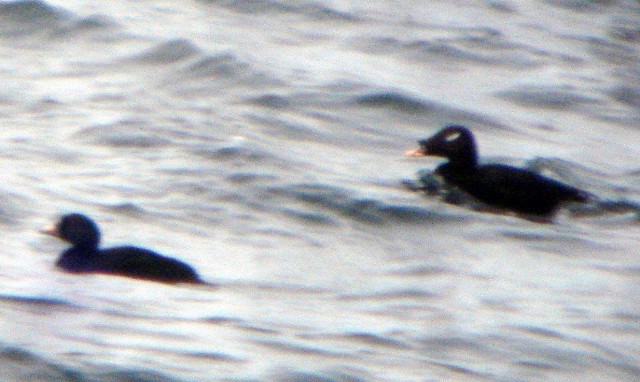
The Rossbeigh Stejneger's Scoter (Photo: Finn Moore)
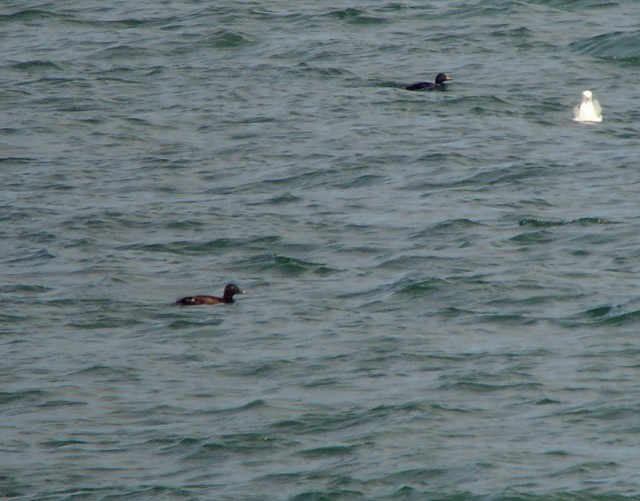
The Aberdeenshire American White-winged Scoter: even at distance, the brown flanks are particularly apparent (Photo: John Nadin)
However, identifying the Musselburgh bird from three heavily cropped images is a little less straightforward — it's easy to see how much the head shape varies between the photos, for example. One consistent feature, though, appears to be the colouration of the bill tip: a rather reddish base with a yellow 'rim', which is clearest in the second (sharpest) image. This pattern is consistent with Stejneger's Scoter; contrastingly, American White-winged shows a yellowish base and central area to the bill, becoming redder towards the sides and tip, as well as an extensive black edge instead of yellow.
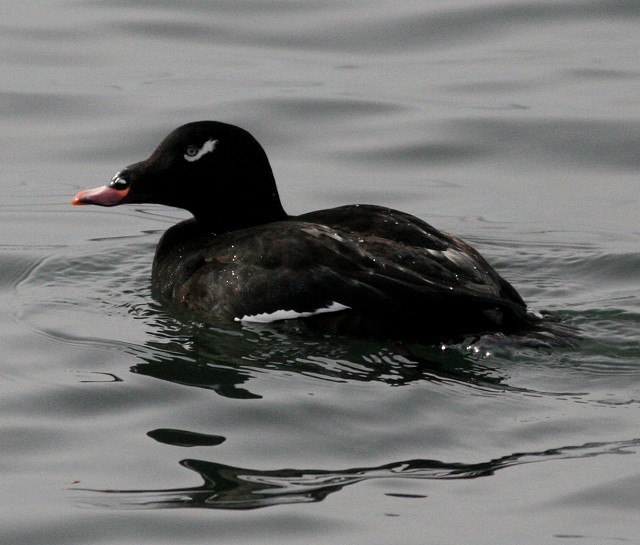
An adult drake American White-winged Scoter photographed in Massachusetts: note the layout of the yellow and red tones to the bill, and the conspicuous black 'rim' (Photo: Mark Pearson)
Plenty more surrounding the identification of Stejneger's Scoter and the features shown by the Musselburgh bird that suggest stejnegeri can be found in a Velvet, White-winged and Stejneger's Scoter photo guide, written by Martin Garner, in February's edition of Birdwatch magazine. Indeed, from what we can see in Sarah-Louise Selly's images, it appears that the Musselburgh bird can be identified with reasonable confidence as Britain's first Stejneger's Scoter (though perhaps not definitively at this stage).
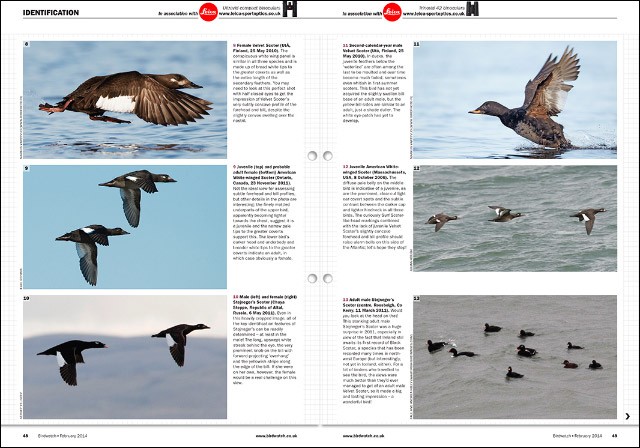
An excerpt from Martin Garner's scoter ID photo guide, in February's issue of Birdwatch magazine.
Although there has been no sign of the bird in question since Boxing Day, there must be a reasonable chance that the bird is still off the Lothian coastline — and who'd bet against a reappearance at Musselburgh? Alternatively, there is presumably a strong possibility that it could turn up at other sites in the Firth of Forth: Ruddon's Point in Fife, for example, has always been a traditional location for scoter flocks.

